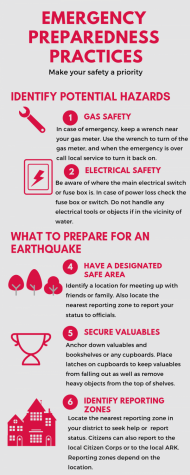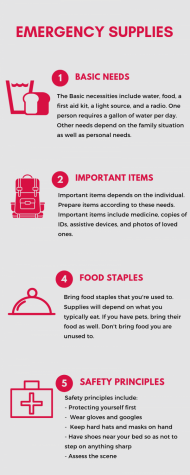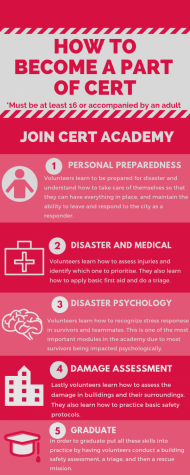Surviving and Thriving: Emergency preparedness experts provide tips and explanations on how to deal with an emergency
Emergency preparedness experts give tips and explanations on how to react in times of emergency.
Cupertino residents attended a emergency preparedness class to learn about what to do in an emergency and how to prepare. Residents were allowed to practice using a fire extinguisher as well as turn off a gas meter. Photo by Sarah Young.
January 28, 2019
California is well known for being an earthquake-prone state. Every year, in preparation to minimize the potential damage from the San Andreas fault, which is refer to as a “ticking time bomb,” students undergo practice drills by taking cover underneath desks, and buildings are routinely checked to see if they’re up to building code. With major earthquakes traditionally occuring along the San Andreas fault every 30 years and the last major earthquake that happened 30 years ago at Loma Prieta with a magnitude of 6.9, another major earthquake is expected to be just around the corner.
Ken Ericksen, a part-time worker for the Office of Emergency Services in Cupertino, became invested in safety because he had many questions about how to keep his family safe. He had also learned CPR and basic first aid. In order to prepare for an earthquake, Ericksen recommends following the “duck and cover” drill, as well as being prepared with the right supplies that fit the needs of a family. The basic kit Ericksen recommends is a pack containing food, water, first aid, a source of light and a radio.


“Everybody has a role in an emergency and the impact that everybody can have with a little bit of training and knowledge has such a big impact on the outcome,” Ericksen said. “Those things for the students and the staff are very important, and the community realizes that those things are in place for where their children go to school, that they’re safe, and they know what to do.”
Ericksen believes that it’s not only important for civilians to know how to prepare for an emergency, but also what the effects an emergency will have on their surroundings. Therefore, anticipation and preparation can help greatly in returning to normal life.
While emergency response works smoothly on a normal day-to-day basis, it becomes less organized during actual times of crisis. Ericksen stresses that civilians must learn to survive even when they don’t have access to resources.
Bob Cascone, a retired paramedic with experience working during emergencies, is personally aware of the limitations of emergency services and how important it is for civilians to be prepared.
“During the Loma Prieta earthquake, I still remember exactly where I was, and looking up Monroe in city of Santa Clara and watching the street move and the light poles and trees move some of the calls I responded on were an hour or more after someone called into 911,” Cascone said. “So there is going to be that gap just because we’re running a call to call and we have to finish with something before we can go on another.”
While emergency preparation classes like the ones that Ericksen recommends prioritize general safety, MVHS Red Cross Club treasurer Aadria Bagchi recommends that students go to their local Red Cross chapter to learn important skills like CPR.
“The MVHS club itself doesn’t have the capacity to bring in a CPR trained person, but you can definitely get CPR certified through Red Cross,” Bagchi said. “There’s a lot of different [sessions] for different emergency situations. For example, if there’s a fire, there’s a class that will teach you how to prepare and what type of kit you should have.”
Although schools hold drills and prepare plans for emergencies, it’s difficult to implement emergency preparedness lessons or CPR lessons in class due to a lack of resources or funding; although MV’s physiology classes include CPR lessons in their curriculum they don’t have CPR certification. Cascone explains that in order to implement these types of lessons, they would need to first talk to the county’s education department and get approval before the lessons could then trickle down into school district and curriculum. Currently, the Santa Clara County Office of Emergency Services has been working with the county executive office to implement more safety lessons over the past few years. They’re also working with the county’s education department to refine some of their own emergency procedures.
Cascone agrees with Bagchi and believes that students should learn these skills early on in life so that it develops into a habit. This is a principle Cascone tries to maintain since retiring, and he hopes students will bring it to their family and friends.

In addition to attending lessons at local Red Cross chapters or emergency preparation classes, civilians can volunteer and become part of their local Community Emergency Response Team (CERT) or report to their local reporting zone. Other resources during times of emergency include the Citizen Corps and the Cupertino Radio.
“I think probably the biggest thing is to think that everybody has a role and a responsibility,” Ericksen said. “With a little bit of information about what’s the plan and understanding what is available on what to expect you and your family can make plans to that and instead of being a victim of something, become a survivor.”


















